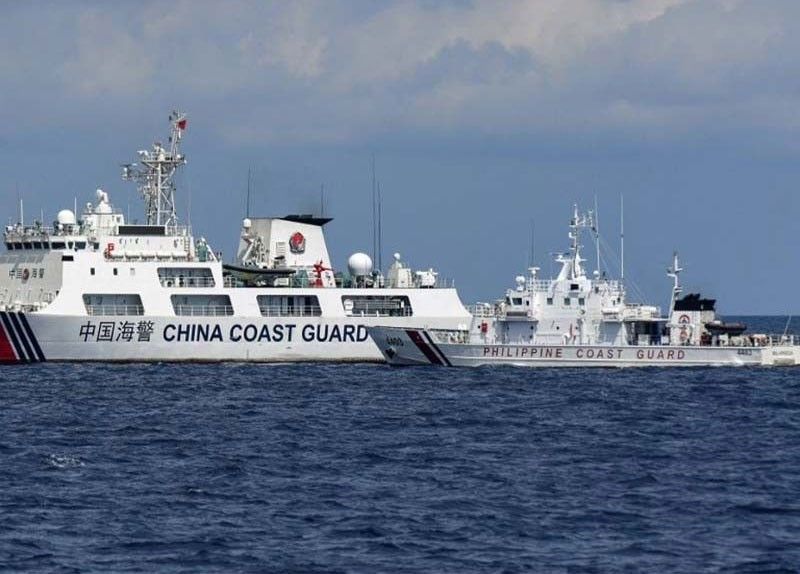China steps up presence in critical areas of West Philippine Sea

MANILA, Philippines — China’s projection of power in the West Philippine Sea continues as more of its vessels – including at least one survey ship – have been spotted in the past seven days at multiple spots in the area where some 3,000 hectares have been reclaimed and transformed into military bases by the Chinese, the Philippine Navy said yesterday.
Data presented by the Philippine Navy at a press briefing showed 122 Chinese vessels operating unchallenged in Philippine waters in the past week, up from 104 the previous week.
Around Pag-asa Island, a community in Palawan, 37 Chinese vessels of various types were spotted, and 30 more were seen in the vicinity of Rozul (Iroquois) Reef.
From July 30 to Aug. 5, 12 Chinese vessels were also sighted in the area of Escoda (Sabina) Shoal, eight in Ayungin (Second Thomas) Shoal, six in Panatag Shoal (Bajo de Masinloc), four each in Julian Felipe Reef and Lawak Island and two in Kota Island.
The Philippine Navy said the foreign vessels include three People’s Liberation Army Navy (PLAN) warships, 12 China Coast Guard (CCG) ships and 106 maritime militia vessels (MMVs).
Chinese presence in the West Philippine Sea was at its lowest in recent weeks
between July 16 and 22, largely due to bad weather brought by Typhoon Carina and the southwest monsoon.
At the height of the Balikatan exercises from May 14 to 20, the number of Chinese ships in the West Philippine Sea was reportedly at its highest in recent months at 153.
Philippine Navy spokesman for the WPS Rear Admiral Roy Vincent Trinidad also said CCG’s largest vessel or the “monster ship” is still in the vicinity of Escoda Shoal, but that it does not appear to threaten or engage the BRP Teresa Magbanua of the Philippine Coast Guard (PCG) in a standoff.
“It’s not a standoff. What happened is that because of our monitoring of the unusual pile up of crushed corals, the Philippine government deployed a ship to monitor the activity there. Its presence is longer than the usual presence that we do and the other side, the Chinese Coast Guard, also deployed their monster ship,” he explained.
“It has been there since July 30 until this morning so we’re watching them, they are watching us, just to ensure that this pile up of corals is not manmade. We hope it’s not manmade and it is only by natural action of the current and the waves,” he said, adding that the Armed Forces of the Philippines (AFP) has increased its presence in Escoda Shoal “just to ensure that there is no manmade activity to pile up crushed corals on the shoal.”
Trinidad also stressed that the PCG does not intend to escalate tension in Escoda Shoal, saying “the flashpoint has been the illegal, coercive, aggressive and deceptive actions of the Chinese Communist Party, which is now the subject of the bilateral consultative meeting between the DFA (Department of Foreign Affairs) and the (Chinese) Ministry of Foreign Affairs.”
Chinese survey vessel
He said the Philippine Navy has also monitored the presence of a Chinese survey vessel called the San Hao for the past 10 days and reported the matter to appropriate agencies.
Trinidad said the survey vessel has been criss-crossing the area of the Panaganiban (Mischief) Reef and Escoda Shoal, and based on DFA records, the ship has not filed a request for the conduct of survey in the area.
He noted that the United Nations Convention on the Law of the Sea (UNCLOS) is silent on the conduct of marine science research and hydrographic surveys, which is why the AFP monitors and reports such activities and issues radio challenges to all vessels inside the country’s exclusive economic zone (EEZ).
Trinidad also said China has reclaimed some 3,000 hectares within the EEZ of the Philippines between 1992 and 2013. Some of the artificial islands are now “major bases” including one on Zamora (Subi) Reef “which, I would like to correct, is outside our EEZ although it is 12 nautical miles, roughly 12 to 15 nautical miles, from Pag-asa.”
“The major bases, Subi (Zamora), Mischief (Panganiban), Johnson (Mabini) are already militarized, they have airstrips, they have harbors for warships, there are structures on land that we can only surmise are aircraft hangers, they have military grade communications equipment,” he told reporters.
“Is there is a creeping invasion? Yes and this began since 1992, since we started noticing Chinese markers in the expanse of the WPS and the South China Sea,” Trinidad said.
- Latest
- Trending




























